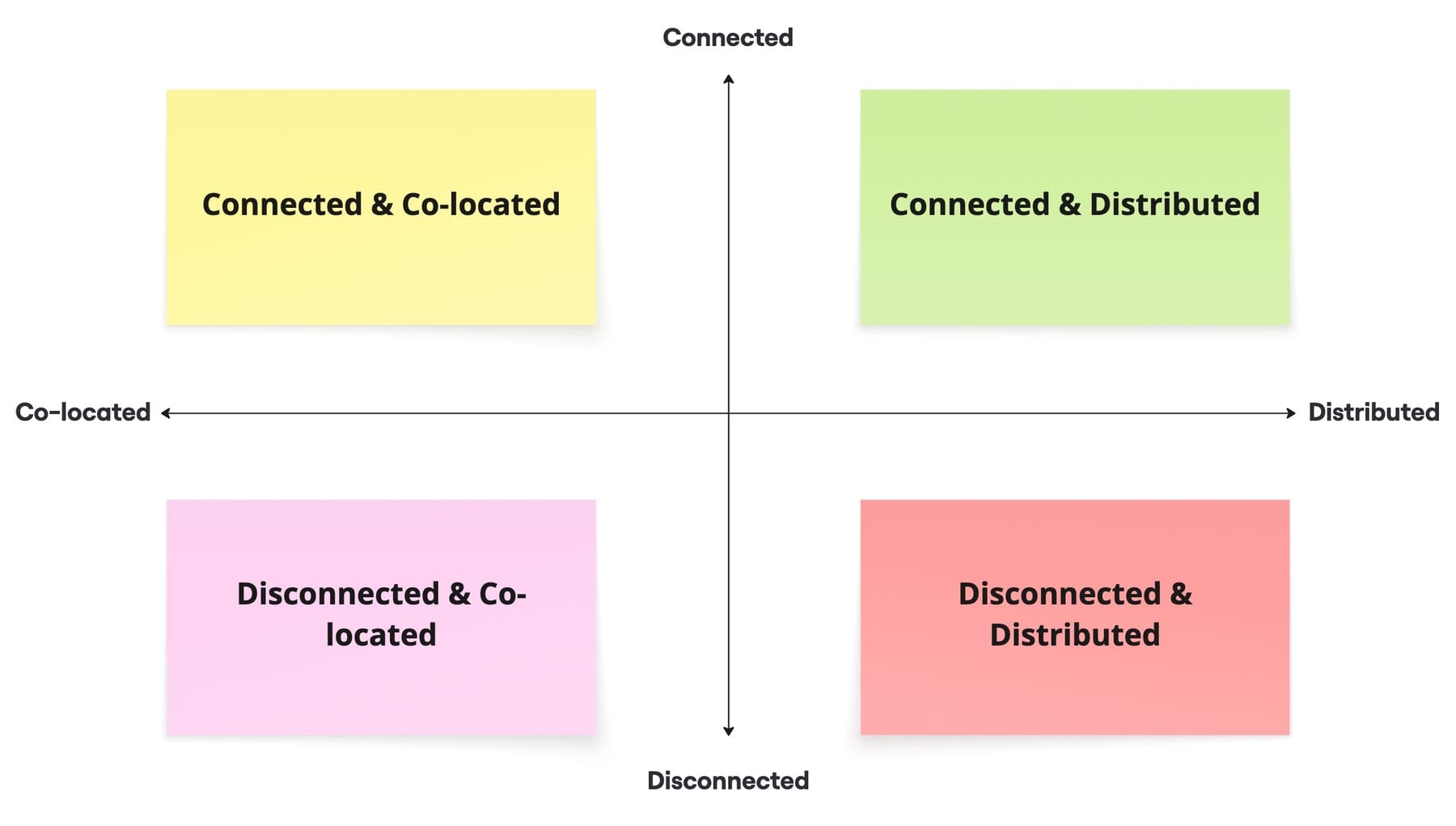
The Connectedness/Location Matrix by Aki Kärkkäinen.
I’ve watched co-located teams sit in the same room without truly connecting. And I’ve seen distributed team members anticipate each other’s thoughts. Physical proximity, it turns out, is a terrible predictor of team cohesion.
Are teams truly more connected just because they share the same office? Are co-located teams a prerequisite for the agile way of working? Not necessarily.
The Two Dimensions That Actually Matter
When working with distributed teams, I’ve noticed something: team success maps onto two dimensions that rarely get discussed together:
- Disconnected ↔ Connected: how much a team shares a sense of purpose and alignment
- Co-located ↔ Distributed: where team members physically sit
Put them together, and you get four distinct team archetypes:
- Disconnected & Co-located → The awkward elevator ride team. Same office, different worlds, sharing a floor plan but not a vision. Conversations stay surface-level despite daily proximity.
- Connected & Co-located → The startup energy team. Fast decisions, culture reinforced daily through osmosis.
- Disconnected & Distributed → The danger zone. Fragmented, misaligned, transactional. Culture is nearly absent. Meetings feel like status reports to strangers.
- Connected & Distributed → The resilient network. United by a strong mission and explicit practices. These teams don’t just survive distribution—they thrive because of it.
Here’s What Matters
💡 Physical proximity is a proxy for collaboration, but connectedness is the real glue.
Physical proximity can mask dysfunction. When teams sit together, we assume they’re collaborating. We mistake shared space for shared purpose. But put that same team in different cities, and the cracks show immediately—the lack of trust & psychological safety, the unclear goals, the transactional relationships.
Distribution doesn’t create these problems. It reveals them.
Why This Matters for Multicultural Teams
Over many years of working almost 100% remotely in internationally distributed teams, I’ve learned this: a strong shared purpose, intentional practices, and servant leadership bridge connection gaps far better than location alone.
For multicultural or cross-border teams, connectedness isn’t a nice-to-have—it’s infrastructure for delivery. Different communication styles, cultural norms around feedback, varying expectations about hierarchy—these differences can fragment a team or enrich it. The difference lies in connectedness.
Every new team starts disconnected. Connectedness doesn’t happen by accident, whether you’re co-located or distributed. You build it actively by meeting people where they are, and finding a frequency that resonates with them.

Photo by Andy Watkins on Unsplash.
Three Ways to Build Connectedness in Multicultural Teams
Get to Know Each Other
Arrange regular unstructured social time to move from transactional relationships (Level 1) to open and trusting relationships (Level 2).
In practice: One distributed team I worked with holds weekly “open space” calls—no agenda beyond connecting as humans. These aren’t team-building exercises—they’re relationship infrastructure.
Clear Communication
Be extra clear about goals and purpose. Visualize and repeat these relentlessly.
In practice: Don’t assume shared understanding. Product teams I coached created a Team Canvas that answered these and other questions: “Why does this team exist?”, “We work together best when…”.
Embrace Flexibility with Accountability
Create space for team members to grow and find their own place within the shared purpose.
In practice: Flexibility isn’t chaos. It means respecting that one team member has elderly parents to care for while another team member works better in evening blocks. It means measuring outcomes, not hours logged.
Aren’t these the same practices for co-located teams? Yes. But you need to be extra intentional about them with distributed multicultural teams. Co-location can hide weak practices. Distribution demands strong ones.
What This Means for Leaders
Connectedness isn’t soft skills theater—it’s how work actually gets done. You cannot build effective, value-delivering teams without it. And you cannot build it by hoping proximity does the work for you.
The question isn’t whether your team is co-located or distributed. The question is: are you building the practices that create real connection? That’s where team capabilities grow.
Once teams experience true connectedness, location becomes almost irrelevant. Those are the resilient teams we want—the ones that can adapt, that can scale, that can handle whatever comes next.
Questions for Reflection
- Where does your team sit in this quadrant today?
- Are you really connected as a team, regardless of where you sit?
- What practices have you seen work for building connectedness in distributed and multicultural teams?
Start by listening and understanding. The answers will show you where to begin.
Footnote
While research on team cohesion and distributed work is extensive, this particular team connection framework—The Connectedness/Location Matrix—emerged from my work with distributed multicultural teams over the years.